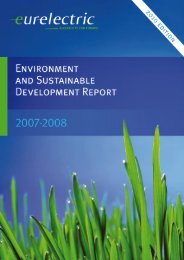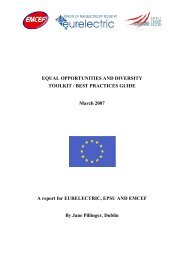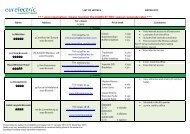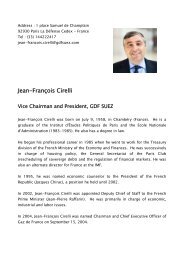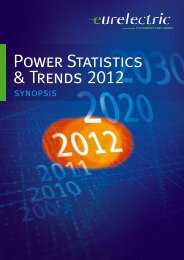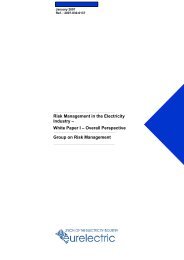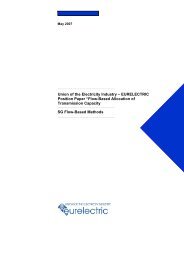Power Statistics - 2010 Edition - Full Report - Eurelectric
Power Statistics - 2010 Edition - Full Report - Eurelectric
Power Statistics - 2010 Edition - Full Report - Eurelectric
You also want an ePaper? Increase the reach of your titles
YUMPU automatically turns print PDFs into web optimized ePapers that Google loves.
Supply<br />
3.4 Comments<br />
AUSTRIA (at)<br />
The expansion of power generation in the upcoming years as well as the time of completion of new power<br />
plants highly depends on the administrative procedure of applying the criteria of the environmental<br />
impact assessments (UVP) legislation.<br />
The estimates provided in this paper about future developments are based on currently published<br />
information about investment projects provided by member companies and on energy forecasts of the<br />
Austrian Institute of Economic Research.<br />
The emphasis of future investment in the upcoming years in Austria’s electricity generation is placed in<br />
the expansion of renewable energies. In terms of the implementation of the EU directive for increasing<br />
the share of renewable energy sources, an Austrian-wide promotion system for “green” electricity and<br />
combined heat and power plants was created in 2002 to raise the share of renewable energy sources<br />
in the generation mix of electricity. The Austrian Green Electricity Act 2008 plans the development of<br />
700 MW each for water and wind power and 100 MW for biomass by the year 2015. Investment in<br />
thermal power plants (especially gas) is also planned to go along with increases in electricity demand.<br />
GERMANy (de)<br />
GENERAL INFORMATION<br />
Data for “Steam Turbine Units”, “Gas Turbine Units”, “Combined Cycle Units”, “Internal Combustion<br />
Units” and “Not specified Technology” in tables 3.1b and 3.3.1b are rough estimates.<br />
The total net capacity of autoproducers (industry) was 10.5 GW in 2009. Additional demand will be<br />
covered by the public utilities and private suppliers. Since 2000 the capacity of the German railway is<br />
included in the public supply.<br />
The net production of industrial autoproducers in 2009 amounts to 45.2 TWh or 8.1% of the total net<br />
production whereas 26.7 TWh was delivered to the public grid.<br />
The feed-in of private suppliers – predominantly wind power followed by biomass – amounts to 67.3 TWh<br />
in 2009 meaning a share of 12.0% of total net production. The quota for renewables in total added up to<br />
more than 16% in 2009.<br />
The industrial consumption in 2009 was covered for 92% from the public grid. In some energy-intensive<br />
industries such as the chemical industry, petroleum industry and mining, the manufacturing of paper or<br />
metal production and the share of autoproduction is higher. Particularly in coal mining areas a closer<br />
relationship exists between public utilities and industrial autoproducers.<br />
LEGAL FACTS<br />
On 1 January 2009, incentive regulation for grid operators started in Germany. The regulation scheme<br />
contains a revenue-cap with two periods each lasting 5 years. Afterwards, a yardstick competition<br />
scheme shall be implemented. Efficiency for grid operators was measured with a dual benchmarking,<br />
whereof the better efficiency value is used. Smaller companies with less than 30,000 customers had<br />
the opportunity to choose a simplified treatment, which allows them not to be part of the benchmarking.<br />
In return, they accept a fixed rate of 87.5% for efficiency in the first period and the average efficiency<br />
as a result of the benchmarking for the second period.<br />
The Renewable Energy Sources Act (Erneuerbare-Energien-Gesetz (EEG)) became effective in March<br />
2000. The increase of the share produced by renewable energies is the declared aim of the EEG. Apart<br />
from changes in the guaranteed fees for each kWh produced, the main improvements of the last<br />
amendment concern the opportunities for a better integration of renewables into the market either by<br />
direct marketing or additional incentives for delivering electricity into the market instead of utilising<br />
the guaranteed fee. Additionally, since January 1 st , <strong>2010</strong>, all fed-in amounts of renewable energy into<br />
the grid due to the EEG has to be sold at the wholesale market (EPEX Spot). This is accomplished by<br />
the TSOs, the legal foundation constitutes the Ausgleichsmechanismusverordnung (AusglMechVO). In<br />
the last amendment of the Renewable Energy Sources Act (Erneuerbare-Energien-Gesetz (EEG)) coming<br />
into effect on August 11 th , <strong>2010</strong> the feed-in tariffs for photovoltaics for new installations since July 1 st ,<br />
<strong>2010</strong> were decreased to slow down the costs induced by this technology. This led to the strong raise<br />
of installed capacities in 2009 and the first half-year <strong>2010</strong>. At mid-year <strong>2010</strong>, more than 12,000 MW of<br />
photovoltaics were installed in Germany representing more than 40% of PV capacities worldwide.<br />
<strong>Power</strong> <strong>Statistics</strong> – <strong>2010</strong> <strong>Edition</strong> – <strong>Full</strong> <strong>Report</strong> 145



